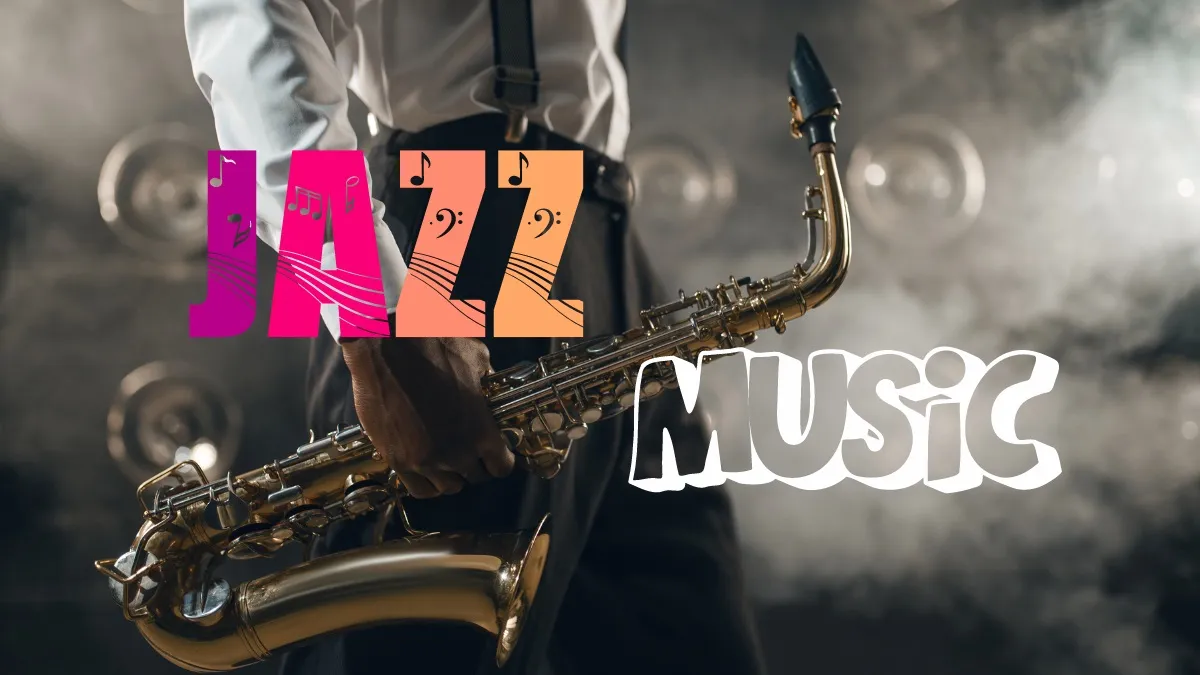It’s not every day that someone goes out of their way to learn more about music. To so many people, music is just some catchy tunes and resonating vocals.
But not you. You actually took the time to ask and seek answers, so major kudos to you if you’re reading this! I’m not exaggerating either, the world of music is filled with confusing terms and complicated aspects that seem to drive people away.
This is why I’ve made it a mission of mine to try and change that view of music by making it more approachable and easier to understand for anyone willing to give it a go. Today, I’m answering the question: what is jazz music?
The term “jazz music” is one of those things that many listeners think they’ll just know when they hear it, but in reality, there’s a lot more to it so it can be quite elusive to pinpoint and discuss.
Does jazz music mean old dance music? Or is it modified blues music? Perhaps it’s both?
Well, I can tell you this now: jazz isn’t that simple. In this article, I’ll be explaining what jazz music is, what characterizes it, its history, its common instruments, its most famous musicians, and much more. Let’s get started!
What is Jazz Music?
Jazz is a music genre of music that features tunes improvised on a variety of instruments and can invoke a wide range of emotions from happiness to sorrow thanks to skillful changes in tempo, texture, and lyrics.
Certain techniques are commonly used as musical elements in jazz music such as “call-and-response”, where one instrument/player replies to another, and bending notes where subtle changes in pitch are made to mimic a singer’s voice, giving a momentary impression that the sound is out of tune.
Explaining Jazz Music
A lot of music experts consider jazz a collaborative form of art that revolves around the creativity of individuals and how they express it through musical instruments. We can trace the very first jazz recording to 1917 where it was made by the Original Dixieland Jass Band and named Livery Stable Blues.
By the 1920s, the ensemble had performed at Buckingham Palace. In the 1930s, Adi Rosner was in Russia heading the State Jazz Orchestra of the Belorussian Republic. Nowadays, jazz has become a worldwide phenomenon.
But how did it all start? Well, let’s travel back to New Orleans at the beginning of the 20th century when the port city was a vibrant center of musical styles and cultures from all over the world.
As a result, instruments from different European countries such as the trumpet and saxophone, as well as improvisation elements and rhythms from Africa, made their way to New Orleans. This coming together of various musical aspects created a suitable environment for these cultures to merge into a unique style which we know today as jazz.
Before the very first recording of jazz music in 1917, music historians can’t say for certain how it developed and came about. However, they do know that jazz music was present way before that time.
According to statements from people who lived before 1917 and earlier recordings, it’s probable that jazz music originated from the combination of a bunch of different styles of folk music from Africa, Ireland, France, Britain, and Spain.
Additionally, jazz music heavily drew from a music form called work song, which is a folk melody that workers sing in a rhythm that matches their labor pace. An example of work song music is capstan shanty that men on ships used to sing in the 1850s.
What are the Characteristics of Jazz Music?
If you’ve ever wondered what jazz music sounds like, then without realizing it, you’re asking about its characteristics.
This should be a simple enough question to answer, but because jazz music overlaps with so many other music genres and styles -from rock to blues to classical- which resulted in a wide range of jazz subgenres, it can be quite tricky to pinpoint a set of characteristics for the genre as a whole.
That being said, there are a few fundamental elements to jazz music that ties together almost all its subgenres and styles, including cool jazz, swing music, bebop, and big band. Below is a summary of the 3 primary characteristics of jazz music:
- Distinctive rhythms —listening to traditional jazz music, it’s not difficult to pick up on their distinctive rhythms of swinging eighth notes. This is where an extra emphasis is added on the first note of an eighth note pair while the second note gets notably lighter so it sort of “swings” as the music moves toward the following note.
- However, I should mention that Latin jazz doesn’t swing. Based on Caribbean music, this style of jazz music features syncopated rhythms that are heavily influenced by Afro-Cuban traditions.
- Harmonic refinement — being harmonically sophisticated is another signature quality of jazz music, which is why it rarely adopts the three-note triad tune that we usually hear in pop, folk, and country music.
- Instead, the vast majority of chords used in jazz music include the seventh chord tone. Also, a lot of them feature ninths, elevenths, and thirteenths tensions.
- Improvisation —the essence of improvisation, probably more than any other quality, is the point of unison for just about all styles and subgenres of jazz music.
As such, you’ll find that any member of a jazz ensemble or band could be played a jazz melody and be asked to improvise over it. From players of the rhythm section to lead instrumentalists to lead vocalists, it’s truly exciting to behold.
What are the Most Common Instruments in Jazz Music?
One of the most interesting aspects of jazz music is that a jazz ensemble can include just about any instrument out there as long as it gives the player enough room for improvising. Below, I’ll be discussing 8 of the most commonly used instruments in jazz bands:
- Drums —in the rhythm section of a jazz ensemble, drums are pretty much the anchor. Typically, you’ll find jazz drummers playing drum sets consisting of 4 or 5 pieces. Some Latin jazz bands include Cajon or other hand percussion instruments along with the drum kit. Examples of great jazz drummers include Max Roach, Art Blakey, and Billy Cobham.
- Bass —it’s very rare for a jazz band to not use either a bass guitar or a double bass. Examples of renowned jazz bassists include Ray Brown, Charles Mingus, Gary Peacock, and Dave Holland.
- Keyboard —in jazz bands, a keyboard refers to either a digital keyboard or a piano, and it’s a staple part of any ensemble. Examples of famous jazz keyboard players and pianists include Bud Powell, Jason Moran, Thelonious Monk, Herbie Hancock, Bill Evans, and Keith Jarrett.
- Guitar —the most common chord instrument in a jazz band, and second to keyboard only, is the guitar. Some of the iconic names in the jazz guitar playing department include Charlie Christian, Joe Pass, Wes Montgomery, Mike Stern, and Pat Metheny.
- Trumpet —most jazz ensembles include a trumpeter, a practice that has been around since the very early days of jazz music in New Orleans. Examples of legendary jazz trumpeters are Louis Armstrong, Dizzy Gillespie, Miles Davis, and Wynton Marsalis.
- Trombone —although the trombone isn’t as showy as the trumpet, it’s managed to take a permanent spot in modern jazz ensembles and big bands. Examples of star jazz trombonists are Turk Murphy and Robin Eubanks.
- Saxophone —the saxophone is known for possessing lightning-fast abilities and being relatively easy to play in tune, and these very characteristics are what made it one of the most popular instruments in jazz bands. Examples of distinguished saxophonists include Coleman Hawkins, John Coltrane, Lester Young, Sonny Rollins, Charlie Parker, Michael Brecker, and Ornette Coleman.
- Lead vocalist —when compared to other popular genres of music, we can see that jazz doesn’t depend so much on a lead vocalist. That being said, there are numerous examples of jazz vocalists who managed to achieve global fame such as Billie Holiday, Sarah Vaughan, and Ella Fitzgerald.
The History of Jazz Music
Jazz is one of the richest genres in music, so it makes sense that it has such a long and eventful history, spanning throughout the 20th century. I’ll be discussing the major eras of jazz music in the section below:
The Early 1900s
When music historians tried to pin down the beginning of jazz music, they traced it back to the early 1900s in New Orleans. At that time, legendary musicians such as Louis Armstrong, King Oliver, and Jelly Roll Morton made music that was heavily influenced by blues, ragtime, and parades’ second-line horn tunes.
Early jazz musicians were even inspired by the funeral music of New Orleans. Later on, southern jazz music from New Orleans eventually got the name Dixieland jazz.
The 1920s and 1930s
In addition to New Orleans, Chicago and Kansas City are also capitals of early jazz music. But if you’re searching for the place that contributed most to establishing jazz music as a cornerstone of American culture, then you should look at New York City.
That’s where big bands featuring famous bandleaders such as Fletcher Henderson and Duke Ellington performed at nightclubs for huge audiences. More specifically, Ellington was known for his composing original pieces that were influenced by classical music and showcased the skills of soloists within his ensemble; Ellington Big Band.
The 1940s and 1950s
Going into the 1940s, a subgenre of jazz music called bebop was developed by musicians of New York such as Bud Powell, Charlie Parker, Art Blakey, and Dizzy Gillespie.
Bop or Bebop is a style of jazz characterized by a quick tempo, solo instrumental excellence, and improvisation that features a mixture of harmonic arrangement and occasional melody references.
Other than that, more and more musicians started to push the harmonic boundaries of traditional jazz music. For example, the Modern Jazz Quartet and Ornette Coleman.
The latter, in particular, is credited with inventing a new subgenre known as free jazz, which strayed away from most song forms that guided typical standards of jazz.
The 1960s
This era is when post-bop or post-bebop came to life. This jazz subgenre slowed things down tempo-wise and worked in some harmonic sophistication. Although lots of musicians started out their careers in bebop, such as Charles Mingus, Thelonious Monk, and Miles Davis, they became more famous for their compositions in the post-bop department.
Later on, Davis created a new subgenre known as cool jazz, which contrasted the intense and fast sound of bop by highlighting slower tempos, less complicated textures, and modal playing. Master saxophonists Sonny Rollins and John Coltrane were equally and highly skilled in bebop, cool jazz, as well as improvisations in post-tonal (such as the Ascension album by John Coltrane).
What’s more, a new subgenre of jazz known as fusion emerged by the work of musicians like Joe Zawinul and Herbie Hancock who combined jazz with rock and funk. Other musicians like Bill Frisell and Pat Metheny turned to folk music for inspiration and came up with a subgenre that featured some of its elements.
What are the Subgenres of Jazz Music?
Jazz music has more than 40 subgenres under its umbrella. Most of these subgenres are grouped into 3 general categories, which are ‘early jazz’, ‘modern jazz’, and ‘jazz related’.
Below is a list of the most common subgenres of jazz music, but remember, there’s still more out there!
Early Jazz
- Big Band
- Boogie Woogie Piano
- Bop or Bebop (the 1940s): a style of jazz music characterized by a quick tempo, instrumental excellence, and improvisation that featured a mixture of harmonic arrangement and occasional melody references.
- Classic Jazz (the 1920s)
- Dixieland (the 1900s): also referred to as New Orleans jazz, early jazz, or hot jazz, the Dixieland style of jazz music originated and developed in New Orleans at the beginning of the 20th century. Essentially, it was a form of Ragtime music, usually exchanged for banjo, brass band, and/or clarinet.
- Jump Blues
- Original New Orleans Jazz
- Ragtime
- Stride Piano (the 1920s)
- Swing (the 1930s -1950s): arrangements played by big bands and are always swung.
- Vocal Jazz
Modern Jazz
- African Fusion
- Afro-Cuban Jazz (the 1940s): consists of a mixture of clave-generated rhythms from Afro-Cuban music as well as jazz harmonies and improvisation techniques.
- Avant-Garde Jazz (the 1950s): a music/improvisation style that features a combination of jazz with avant-garde music and composition.
- Bossa Nova
- Cool Jazz (the 1940s -1960s): on the opposite side of the intense and fast sound of bop, mostly based on Lester Young.
- Eclectic Fusion
- Funk Jazz (the 1970s): characterized by a strong groove or backbeat, electrified tones, and analog synthesizers (early appearance).
- Fusion
- Hard Bop (the 1950s): contains influences from RnB, blues, and gospel music, particularly in piano and saxophone playing
- Latin Jazz: heavily influenced by salsa and merengue music, featuring a lot of percussions such as congas, guiros, bongos, timbales, and others.
- Nu Jazz (the 1990s): a style that fuses elements of jazz music with other styles of music such as soul, electronic dance music, funk, and loose improvisation.
- Post Bop (the 1960s): a small-combo genre of jazz that fully adopts free jazz, hard bop, avant-garde, and modal jazz, without being necessarily instantly recognized as any one of those styles.
- Post-Fusion Contemporary
- Progressive Big Band
- Soul Jazz
- World Fusion
- 21st Century Modern
Jazz Related
- Acid Jazz (the 1980s – 1990s): incorporates a combination of elements from funk, disco, and soul music such as modal harmony and looping beats
- Blues
- Dub/Ska/Reggae
- Exotica
- Funk
- Jazz Education
- Jazz Related Electronica/Hip-Hop
- Jazz Related Gospel
- Jazz Related Improv/Composition
- Jazz Related Rock
- Jazz Related Soundtracks
- Latin Rock/Soul
- Pop/Art Song/Folk
- RnB
- Third Stream (the 1950s): a fusion of classical stream music and jazz stream music.
Who are the Most Famous Musicians in Jazz Music?
In alphabetical order, these are:
- Art Blakey (1919 to 1990)
- Billie Holiday (1915 to 1959)
- Charlie Parker (1920 to 1955)
- Dave Brubeck (1920 to 2012)
- Duke Ellington (1899 to 1974)
- Ella Fitzgerald (1917 to 1996)
- Herbie Hancock (1940 to present)
- John Coltrane (1926 to 1967)
- Louis Armstrong (1901 to 1971)
- Miles Davis (1926 to 1991)
What are the Best Albums in Jazz Music?
The following list contains some of my (and many people’s) all-time favorites:
- New Orleans: The Definitive by Sidney Bechet
- Chicago: The Complete Hot Five and Hot Seven Recordings by Louis Armstrong
- New York: Music for Moderns by Paul Whiteman
- Swing: The Definitive Benny Goodman
- Bebop and Free Jazz: The Definitive Charlie Parker
- Jazz Fusion: Head Hunters by Herbie Hancock
- Postmodern: Rush Hour by Joe Lovano
















